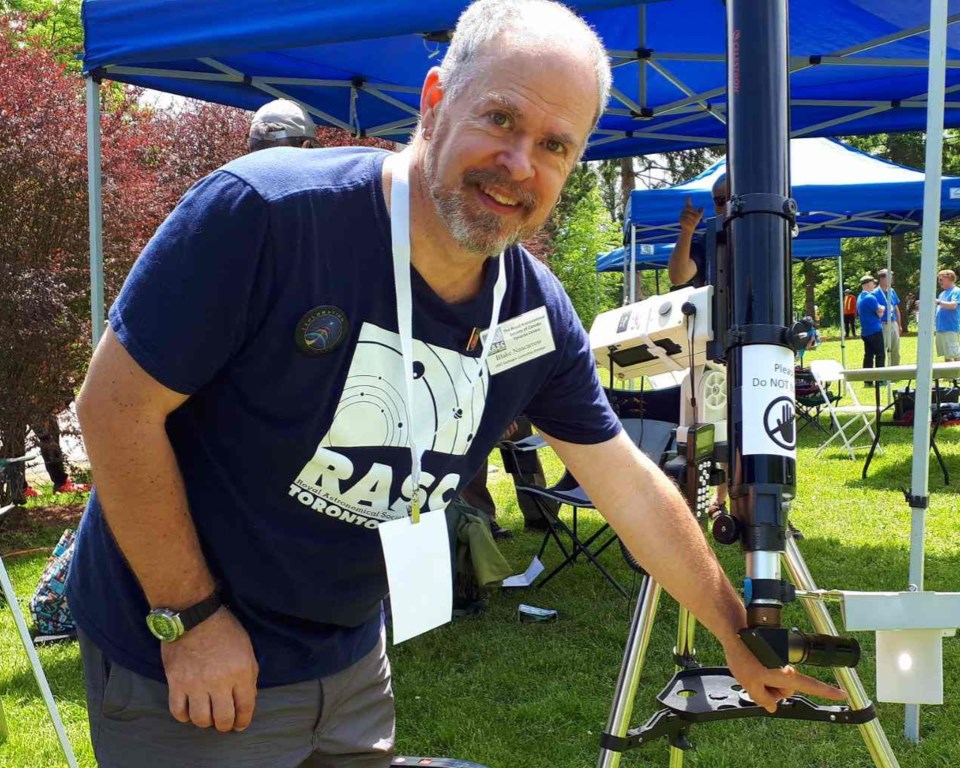On Monday morning, through to 1 p.m. Eastern Standard Time, the tiny planet Mercury will pass in front of the sun. This is called a solar transit.
The inner planets of the solar system, Mercury and Venus, regularly pass between the Earth and the Sun. The alignment of all these celestial bodies needs to be just right to witness a transit event. Of course, the viewer also needs to be on the correct side of the Earth with clear skies.
Most importantly, during solar transits, protection is needed. Like with solar eclipses, proper astronomical solar filters are required for eyes, camera lenses, and telescopes to safely view or photograph the Sun.
The last transit of Mercury (ToM) was on May 9, 2016. And the next ToM is Nov. 13, 2032, but that one won't be visible from Ontario. It's not until May 7, 2049 that we'd be able to taken in a Mercury transit without travelling. Transits of Venus are less common.
A lot of science can be done during transits, such as measuring the variability of the Earth's rotation and the tidal acceleration of the Moon.
We can also detect variations in the Sun's radius. A fascinating thing about transits is that it is the same effect observed and recorded by planet-hunting space probes.
The Transiting Exoplanet Survey Satellite (TESS) that a friend of mine works on watches for small dips in the light from distant stars in our galaxy to detect the presence of exoplanets. With a good watch or timer app, you could measure the stages of the transit.
A combination of factors make this a challenging observation. Planet Mercury is small, about 4,900 kilometres in diameter (a bit bigger than our Moon). While on the same side of the Sun as us, the inner-most planet will still be far from the Earth, around 100 million kilometres. The Sun is big and bright, of course.
If you have proper solar eclipse glasses, you could have a go at Mercury. I tried to do that back in 2016, but I couldn't see the tiny dot with just my eyes. One of my friends, with better than 20-20 vision, could not see it either. (Caution: Do not wear your solar glasses and then use your binoculars! This would burn holes through the glasses!)
With solar filters on the front of your binoculars, you might be able to spot the small round dot. Focus carefully.
It will be easier to see Mercury in a telescope. Once again, correct filtration is essential.
I'll be using my Baader Planetarium Mylar visual-grade solar filter on the front of my telescope. Unless using a Herschel wedge energy rejection system, proper filters are needed on the front of all telescopes during solar viewing.
If in doubt, do not take any chances! If children are viewing with you, ensure they do not remove filters.
A safe, easy way to try to spot Mercury is to use projection. You could use binoculars or a small telescope with the eyepiece installed.
Let the sunlight pass through the telescope. Place a white card near the eyepiece and you'll see the white disc of the Sun projected onto the card. Inspect the image carefully for a small black disc. If we're lucky, we'll see a sunspot or two as well.
Seek out astronomy societies or clubs conducting activities. The Riverwood Conservancy is having a transit viewing solar party with help from the RASC Mississauga Centre. And some RASC Toronto Centre members are planning to be at Woodbine Beach.
...
— This article is contributed by Blake Nancarrow, an avid amateur astronomer. If not observing from his backyard in Bradford, he can be found under the stars at a club observatory on the Blue Mountains or at the David Dunlap Observatory in Richmond Hill. He is a contributing editor for the Royal Astronomical
Society of Canada Journal.



